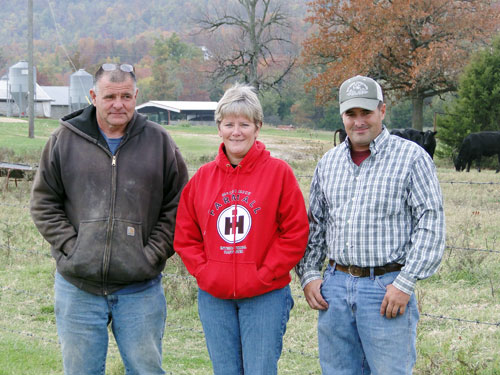In the countryside outside of Green Forest, Ark., is a neat, parent-son farm with seven Butterball Turkey houses, up to 200 momma cows, 10 bulls and 70 to 140 acres devoted to no-till corn. Richard and Lesa Gordon and their son, Mark, work on the farm full time while Mark’s wife Dustina teaches school.
In the mid 1950s, Lesa’s family moved from Texas to Arkansas and bought the 300 acres the Gordons now farm. Originally the farm was a feeder pig operation but the opportunity stopped several years before Richard and Lesa took over and built the turkey houses. They also lease an additional 750 acres to help support the cattle herd.
Richard always liked Gelbvieh, but Black Angus were added when Mark finished school. They also have a horned Hereford bull. The Gordons like to calve in the spring and fall, but this last year an Angus bull turned “meaner than the devil and messed us up. We couldn’t get him loaded up at the right time… and now he’s gone,” said Richard.
When they work cattle they use horses. Mark is more than comfortable in the saddle. He was on the US Team Roping National Champion Header Team in 2006. Though Mark came back to the farm full time only three years ago before which Lesa and Richard ran the whole operation by themselves, he and his dad have partnered in cattle for many years. Richard said, ‘”It’s almost impossible to start by yourself.” The plan is for Mark to take over the whole operation some day.
The turkey part of the operation began when Richard built houses about 20 years ago and then bought his neighbor out. The houses sit on the level valley floor and provide a beautiful view of American farming today from the Gordons’ bluffs above. The Gordons also milked cows in the early years but found that milking and turkeys were both labor intensive, so they chose to stay with the turkeys and gave up milking.
Mark said, “Today’s farm has to do a little bit of everything to survive.” A good example of that philosophy is the corn they raise. A few years back one of Richard’s friends, a dairyman, was struggling with the price of feed. They got together, bought planting equipment and raised corn in 30 inch rows for silage to decrease their feed costs. This turned out well for both, especially in light of the drought last year. Richard said, “My bin didn’t get full this year, but with what I hayed this summer, I should be able to get through the winter without buying any hay. We didn’t get two cuttings on a lot of it, but what we did get was pretty decent.”
Richard also searched the Internet and found a silage chopper in Nebraska that was about 30 years old. He got a trailer and went and got it. In addition Richard is in the process of building a 40×60’ shop to protect the tractors and to work on equipment. He laughed and said, “I’m using it even before it gets done.”
The Gordons use an ear tagging system on their calves that simplifies keeping accurate records. The number is a combination of the year the momma was born and the birth year of the calf. Bull calf tags go in the right ear and heifers in the left. That way the Gordons can tell at a glance the genetic background and sex of each calf.
Lesa loves the farm as much as the men. Though she worked off the farm for many years, she was glad when she worked on-the-farm full time. She said, “The pleasure is being at home and setting your own hours rather than putting them in for someone else.”
Mark echoed his mother’s sentiments. He said, “Look out the window. It’s home and away from all of the people.”
Richard pointed out another advantage of being on the farm: he has the luxury of doing things his ways. He grinned and said, “It takes an act of Congress to get me to change my ways. I still use the same bank, feed store and sale barn. And I do business by a shake of my hand with people I know and trust. We all stick together, and the only time I’ll lie to you is at the coffee shop.”




